|
|
|
|
|
|
|
Achi-Kochi Japan
Showing many places to visit and foods to eat in Japan
|
|
|
|
|
|
|
|
|
|
|
|
|
Japan
> Tohoku region
> Shirakami Sanchi
|
|
|
|
|
|
|
Shirakami Sanchi
Aomori and Akita, Tohoku ( Achi-Kochi Japan )
|
|
|
|
|
|
|
|
|
|
|
|
|
( "Achi-Kochi" in Japanese means "Here and there" in English. )
Shirakami Sanchi,
Aomori Pref. and Akita Pref., Tohoku
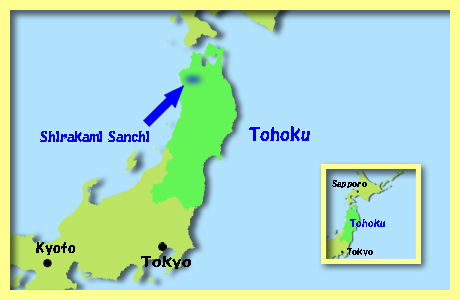
Shirakami Sanchi, one of UNESCO World Natural Heritage Sites, is located in Aomori Pref. and Akita Perf., in Tohoku region. In the "Sanchi" ( mountainous area ), there remain primeval forests of beech trees, in which tourists could walk along the paths.
Also there are lakes and waterfalls in the forests. Tourists could enjoy viewing such landscapes as well as seeing wild animals and birds.
|
|
Anmon Information Office

To the beech forests of Shirakami Sanchi, there are a few entrances, one of which is Anmon Information Office ( above ), where visitors could obtain information relating to walking in the forests.
|
|
Drinks and Foods

At Anmon Information Office, drinks and foods such as sandwiches and Onigiri ( Japanese rice balls - above ) are sold, which could help visitors walking around. Also around the information office, there are a bus stop, a restaurant, a souvenir shop, a public bath, cottages, a camp site, toilets and so on.
|
|
Walking in Beech Tree Forest
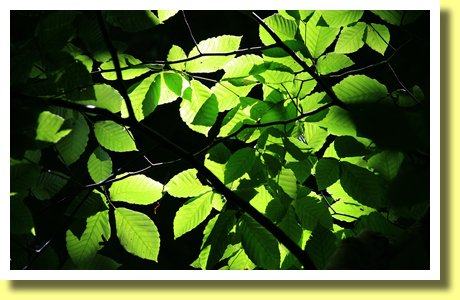
There is a walking path in the beech tree forest near Anmon Information Office. Walking in the forest is refreshing while leaves of beech trees are shining as above.
|
|
Nihonzaru
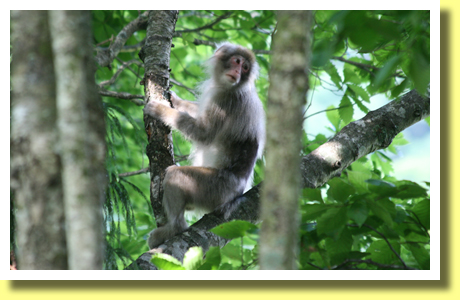
In the forest, visitors could see residents such as a Nihonzaru ( Japanese macaque - above ). Nihonzaru are native to Japan and known as snow monkey. They live even in heavy snow areas including Shirakami Sanchi but not in Hokkaido.
They survive in the temperature as low as minus 20 degree in Celsius. They are the nonhuman primate living in the northernmost areas. Also it is known that some of Nihonzaru take hot spring baths in Koh-Shin-Etsu Region.
|
|
Deeper into the forests

To go deeper into the beech tree forests, walking a mountain path from Tsugaru Toge ( Tsugaru Pass ) down to Anmon Information Office could be recommended. Along the path, old and big beech trees ( as above ) could be seen. It would take 5-6 hours to walk through the pass ( about 5.6 km ). The path is closed through snowfall - end of May. Drinks, food and rain gear are required.
Near Tsugaru Toge ( pass ), there is a beech tree, called "Mother Tree". It is said that the tree is abour 400 years old. However the trunk of the tree was broken by a strong wind in September 2018.
They say that the primeval beech forests in Shirakami Sanchi have survived for about 10,000 years ( since Jomon Period ). Some mountains in the area have altitude higher than 1,000m above sea level. The Sea of Japan brings a heavy snow to this area. In addition, it had been thought that beech trees were worthless economically and there had been no roads nor trails in most of the area. So the primeval forests have survived in Shirakami Sanchi.
|
|
Anmon no Taki ( Waterfalls )

Near Anmon Information Office, Anmon no Taki ( Anmon Waterfalls ) are popular among tourists. Tourists could walk in the beech tree forests and along the mountain stream to the waterfalls ( above ).
From Anmon Information Office it takes about 1 hour ( about 1.1km ) to walk to the 3rd waterfall, and about 15 minutes ( about 0.2 km ) from the 3rd to the 2nd waterfall. The walking pth would be open through early July - snowfall. However the path from the 2nd waterfall to the 1st is not ready.
|
|
Aoike, Juniko
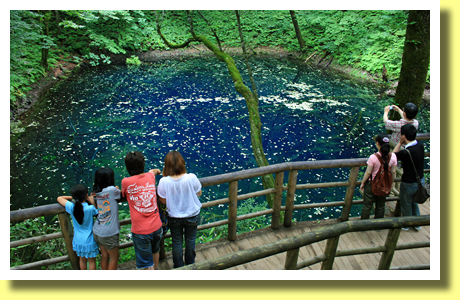
In Shirakami Sanchi, Juniko area is popular among tourists as well as Anmon area. In particular, Aoike ( above ) is famous in Juniko area. "Ao" in Japanese means "bule" while "Ike" does "lake or pond". So "Aoike" means "blue lake/pond" as it looks.
|
|
Walking paths in Juniko
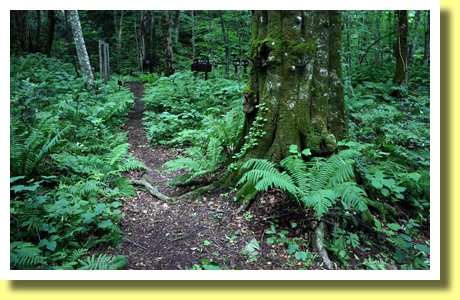
"Juniko" in Japanese means "twelve lakes/ponds" though there are more than 30 lakes/ponds in Juniko area. Walking paths ( as above ) in the forests would help visitors walk around lakes/ponds including Aoike.
In A.D.1704, the area was attacked by an earthquake, which caused streams being dammed up and depression/cave-in here and there. So lakes and ponds were created.
|
|
Akashobin ( Ruddy Kingfisher )

While walking around lakes/ponds, visitors could see wild animals/birds such as Akashobin ( Ruddy Kingfisher - above ). Ruddy Kingfishers live around east and southeast Asia and fly to Japan in summer.
They like deep forests and feed on frogs, amphibians, fish, crustaceans and insects. So Juniko would be one of their favorite places.
|
Copyright (c) 2021 Achi-Kochi Zanmai Co., Ltd.
|